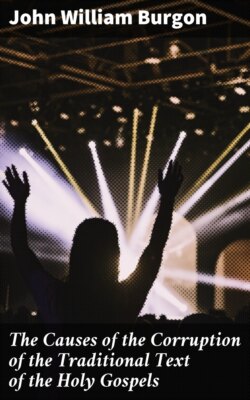Читать книгу The Causes of the Corruption of the Traditional Text of the Holy Gospels - John William Burgon - Страница 35
На сайте Литреса книга снята с продажи.
Оглавление[61] It is clearly unsafe to draw any inference from the mere omission of ηδη in ver. 35, by those Fathers who do not shew how they would have began ver. 36—as Eusebius (see below, note 2), Theodoret (i. 1398: ii. 233), and Hilary (78. 443. 941. 1041).
[62] i. 219: iii. 158: iv. 248, 250 bis, 251 bis, 252, 253, 255 bis, 256, 257. Also iv. 440 note, which = catox iv. 21.
[63] dem. 440. But not in cs. 426: theoph. 262, 275.
[64] vii. 488, 662: ix. 32.
[65] i. 397. 98. (Palladius) 611: iii. 57. So also in iv. 199, ετοιμος ηδη προς το πιστευειν.
[66] Ambrose, ii. 279, has 'Et qui metit.' Iren.int substitutes 'nam' for 'et,' and omits 'jam.' Jerome 9 times introduces 'jam' before 'albae sunt.' So Aug. (iii.^2 417): but elsewhere (iv. 639: v. 531) he omits the word altogether.
[67] 'Hic' is not recognized in Ambrose. Append. ii. 367.
[68] The Fathers render us very little help here. Ps.-Chrys. twice (viii. 34: x. 838) has εγω δε ωδε: once (viii. 153) not. John Damascene (ii. 579) is without the ωδε.
[69] i. 76: vi. 16 (not vi. 484).
[70] iii.2 259 (not v. 511).
[71] p. 405.
[72] [The prodigal was prepared to say this; but his father's kindness stopped him:—a feature in the account which the Codexes in question ignore.]
[73] iii. 687. But in i. 228 and 259 he recognizes θεου.
[74] Ap. Mai vii. 135.
[75] Praep. xiii. 6—μονου του 'ενος (vol. ii. 294).
[76] Same word occurs in St. Mark iv. 37.
[77] iii. 101.
[78] Falconer's Dissertation on St. Paul's Voyage, pp. 16 and 12.
[79] Let the learned Vercellone be heard on behalf of Codex B: 'Antequam manum de tabulâ amoveamus, e re fore videtur, si, ipso codice Vaticano inspecto, duos injectos scrupulos eximamus. Cl. Tischendorfius in nuperrimâ suâ editione scribit (Proleg. p. cclxxv), Maium ad Act. xxvii. 14, codici Vaticano tribuisse a primâ manu ευρακλυδων; nos vero ευρακυδων; atque subjungit, "utrumque, ut videtur, male." At, quidquid "videri" possit, certum nobis exploratumque est Vaticanum codicem primo habuisse ευρακυδων, prout expressum fuit tum in tabella quâ Maius Birchianas lectiones notavit, tum in alterâ quâ nos errata corrigenda recensuimus.'—Præfatio to Mai's 2nd ed. of the Cod. Vaticanus, 1859 (8vo), p. v. § vi. [Any one may now see this in the photographed copy.]
[80] Ap. Galland. x. 225.
[81] Remark that some vicious sections evidently owed their origin to the copyist knowing more of Latin than of Greek.
True, that the compounds euronotus euroauster exist in Latin. That is the reason why the Latin translator (not understanding the word) rendered it Euroaquilo: instead of writing Euraquilo.
I have no doubt that it was some Latin copyist who began the mischief. Like the man who wrote επ' αυτω τω φορω for επ' αυτοφωρω.
Readings of Euroclydon
ΕΥΡΑΚΥΔΩΝ B (sic)
ΕΥΡΑΚΥΛΩΝ [Symbol: Aleph]A
ΕΥΡΑΚΗΛΩΝ
ΕΥΤΡΑΚΗΛΩΝ
ΕΥΡΑΚΛΗΔΩΝ Peshitto.
ΕΥΡΑΚΥΚΛΩΝ
Euroaquilo Vulg.
ΕΥΡΟΚΛΥΔΩΝ HLP
ΕΥΡΑΚΛΥΔΩΝ Syr. Harkl.
ΕΥΡΥΚΛΥΔΩΝ B2 man.
[82] Οπου (ου [Symbol: Aleph]) γαρ (—γαρ [Symbol: Aleph]BDL) εαν (αν D) το πτωμα (σωμα [Symbol: Aleph]).
[83] Sancti Dei homines.
[84] Ap. Galland. x. 236 a.
[85] Trin. 234.
[86] iii. 389.
[87] 'Locuti sunt homines D.'
[88] Their only supporters seem to be K [i.e. Paul 117 (Matthaei's §)], 17, 59 [published in full by Cramer, vii. 202], 137 [Reiche, p. 60]. Why does Tischendorf quote besides E of Paul, which is nothing else but a copy of D of Paul?
[89] Chrys. xii. 120 b, 121 a.
[90] Theodoret, iii. 584.
[91] J. Damascene, ii. 240 c.
[92] St. Matt. xxvii. 17.
[93] Cf. 'ο λεγομενος Βαραββας. St. Mark xv. 7.
[94] Int. iii. 918 c d.
[95] On the two other occasions when Origen quotes St. Matt. xxvii. 17 (i. 316 a and ii. 245 a) nothing is said about 'Jesus Barabbas.'—Alluding to the place, he elsewhere (iii. 853 d) merely says that 'Secundum quosdam Barabbas dicebatur et Jesus.'—The author of a well-known scholion, ascribed to Anastasius, Bp. of Antioch, but query, for see Migne, vol. lxxxix. p. 1352 b c (= Galland. xii. 253 c), and 1604 a, declares that he had found the same statement 'in very early copies.' The scholion in question is first cited by Birch (Varr. Lectt. p. 110) from the following MSS.:—S, 108, 129, 137, 138, 143, 146, 181, 186, 195, 197, 199 or 200, 209, 210, 221, 222: to which Scholz adds 41, 237, 238, 253, 259, 299: Tischendorf adds 1, 118. In Gallandius (Bibl. P. P. xiv. 81 d e, Append.), the scholion may be seen more fully given than by Birch—from whom Tregelles and Tischendorf copy it. Theophylact (p. 156 a) must have seen the place as quoted by Gallandius. The only evidence, so far as I can find, for reading 'Jesus Barabbas' (in St. Matt. xxvii. 16, 17) are five disreputable Evangelia 1, 118, 209, 241, 299—the Armenian Version, the Jerusalem Syriac, [and the Sinai Syriac]; (see Adler, pp. 172–3).
